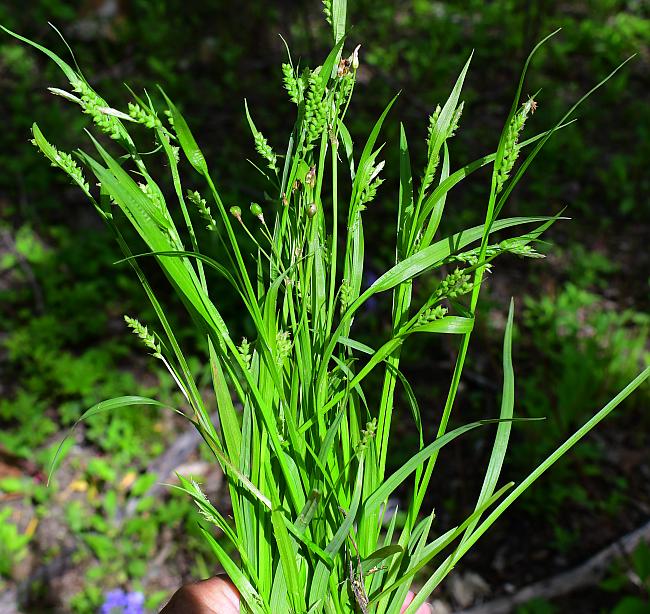Carex blanda Dewey
Common Wood Sedge

Native
CC = 2
CW = 0
MOC = 110
© SRTurner
Carex blanda DeweyCommon Wood Sedge | |
 |
Native CC = 2 CW = 0 MOC = 110 |
© SRTurner |
|
Family - Cyperaceae Habit - Monoecious sedge, with short or absent rhizomes, forming dense clumps. Stems - Vegetative stems nearly as long as the flowering stems, more than 5 cm long, the leaves 1-10 mm wide, slightly to noticeably wider than those of the flowering stems, dull green to grayish green, sometimes somewhat glaucous. Flowering stems 10-60 cm long, sharply trigonous, easily crushed, sometimes narrowly winged on the angles, white to light brown at the base. Stem bases whitened.
Leaves - Leaf blades 1-30 cm long, 3-8 mm wide. Lowermost, nearly bladeless sheaths white to light brown.
Inflorescence - Spikes 4-5 per stem, the bracts leaflike, prominent, the uppermost longer than the inflorescence. Staminate spike 9-20 mm long, sessile or short-stalked, sometimes hidden by the uppermost pistillate spikes and bracts. Pistillate spikes 15-20 mm long, 3-4 mm wide, the upper 2 often nearly sessile and crowded at the base of the staminate spike, the others loosely spaced along the upper half of the inflorescence, short-to long-stalked, ascending, with 4-18 perigynia. Scales of the staminate spikes 1.8-3.2 mm long, oblong to obovate, tapered to a noticeable awn at the tip, yellowish white to white, with a green midrib. Pistillate scales 2.8-3.0 mm long, obovate to oblong-elliptic, rounded to bluntly pointed at the tip, the midrib extended as a short to long awn, yellowish white to white, with a green midrib.
Perigynia - Perigynia 2.4-4.0 mm long, obovate in outline, the short beak abruptly bent.
Fruits - Achenes 2.0-3.5 mm long, obovate to elliptic in outline. Flowering - April - July. Habitat - Swamps, forests, riverbanks, lawns, roadsides, and disturbed, shaded areas. Origin - Native to the U.S. Lookalikes - Several other species of Carex. Other info. - This is one of the most common sedges in Missouri, probably occurring in every county. It is typically found in woodlands, but is not particular about moisture levels. The perigynia are rounded in cross section. A hallmark of this species are the tips of the perigynia. These are abruptly bent and point sideways, as shown in the photos. The clumps contain well-developed vegetative stems, and the plant bases are whitened and not reddish. Photographs taken at Shaw Nature Reserve, Franklin County, MO, 5-2-2021 (SRTurner). |